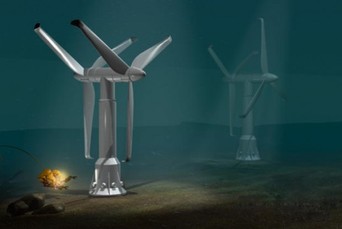
Better than wave power, which requires buoy farms floating in the middle of the ocean and can be problematic for ships passing by, tidal power has turbines sitting on the sea floor. A great benefit of tidal power plants is their very high capacity factor hovering around 98%, i.e. better than a nuclear or coal plant. Tidal and hydro power are the only renewable sources that can provide base load power to the grid and therefore hold the most promise – wind and solar require some type of energy storage.
South Korea, the UK and France all have tidal projects in progress, or completed. So contrary to what the article below says the technology is there! Capital costs are probably high, because these projects haven’t been done quite enough yet, to bring the cost down, but once built, energy is essentially free, just some operational and maintenance costs which are probably equivalent or lower than other power plant types.
Tidal projects also come with decent capacity. The South Korean Sihwa Lake Tidal Power Station, which opened last April, is 254MW. So yes it can be done. The US is simply behind, or has a different agenda.
~~~~~~~~~~~~~~~~~~~~~~~~~~~~~~~~~~~~~~~~~~~~~~~~~~
Ocean wave power projects seek solid footing on West Coast
By Mike Lee
San Diego Union Tribune
08/15/2011
Harnessing power from ocean waves or currents has a big upside but it also has could have negative impacts on the ocean environment, according to a 2008 report by Oregon State University and others. Posisble problems include:
• Pelagic habitat: Minimizing entanglement of sea turtles in loose lines is crucial and some scientists are concerned about potential effects of electromagnetic fields created by the operations.
• Benthic habitat: Wave-energy facilities likely will affect local currents and that may change the movement of sediment and larvae. Organisms growing on buoys, cables and anchors may alter sandy seafloor environments where they will be placed.
• Fish: Large facilities could affect migration of salmon, crabs, sturgeon, whales and other creatures.
• Seabirds: Above-water structures may attract birds and alter food webs.
• Marine mammals: Mooring cables may lead to animals getting unintentionally snared.
The cancellation of three ocean wave-energy projects in Sonoma County leaves a proposal north of Oceanside as the only one of its kind off California’s coast.
There’s wide interest in harnessing the ceaseless power of the ocean because so-called hydrokinetic energy facilities could provide a steady source of energy without air pollution or toxic waste.
But there are so many barriers that the concept hasn’t generated much momentum in California despite aggressive state mandates to ratchet up renewable power supplies. To reach commercial production, a wave-energy farm proposed near San Onofre would have to minimize interference with ocean ecosystems, the famous surf break at Trestles and Marine training at Camp Pendleton. Besides that, proponents must prove the technology will work in the corrosive waters of the ocean and navigate a grueling approval process.
Read full article here
South Korea, the UK and France all have tidal projects in progress, or completed. So contrary to what the article below says the technology is there! Capital costs are probably high, because these projects haven’t been done quite enough yet, to bring the cost down, but once built, energy is essentially free, just some operational and maintenance costs which are probably equivalent or lower than other power plant types.
Tidal projects also come with decent capacity. The South Korean Sihwa Lake Tidal Power Station, which opened last April, is 254MW. So yes it can be done. The US is simply behind, or has a different agenda.
~~~~~~~~~~~~~~~~~~~~~~~~~~~~~~~~~~~~~~~~~~~~~~~~~~
Ocean wave power projects seek solid footing on West Coast
By Mike Lee
San Diego Union Tribune
08/15/2011
Harnessing power from ocean waves or currents has a big upside but it also has could have negative impacts on the ocean environment, according to a 2008 report by Oregon State University and others. Posisble problems include:
• Pelagic habitat: Minimizing entanglement of sea turtles in loose lines is crucial and some scientists are concerned about potential effects of electromagnetic fields created by the operations.
• Benthic habitat: Wave-energy facilities likely will affect local currents and that may change the movement of sediment and larvae. Organisms growing on buoys, cables and anchors may alter sandy seafloor environments where they will be placed.
• Fish: Large facilities could affect migration of salmon, crabs, sturgeon, whales and other creatures.
• Seabirds: Above-water structures may attract birds and alter food webs.
• Marine mammals: Mooring cables may lead to animals getting unintentionally snared.
The cancellation of three ocean wave-energy projects in Sonoma County leaves a proposal north of Oceanside as the only one of its kind off California’s coast.
There’s wide interest in harnessing the ceaseless power of the ocean because so-called hydrokinetic energy facilities could provide a steady source of energy without air pollution or toxic waste.
But there are so many barriers that the concept hasn’t generated much momentum in California despite aggressive state mandates to ratchet up renewable power supplies. To reach commercial production, a wave-energy farm proposed near San Onofre would have to minimize interference with ocean ecosystems, the famous surf break at Trestles and Marine training at Camp Pendleton. Besides that, proponents must prove the technology will work in the corrosive waters of the ocean and navigate a grueling approval process.
Read full article here


 RSS Feed
RSS Feed